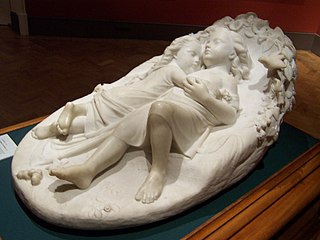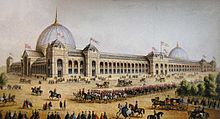
A world's fair, also known as a fun exhibition or an expo, is a large global exhibition designed to showcase the achievements of nations. These exhibitions vary in character and are held in different parts of the world at a specific site for a period of time, typically between three and six months.

The 1967 International and Universal Exposition, commonly known as Expo 67, was a general exhibition from April 28 to October 27, 1967. It was a category one world's fair held in Montreal, Quebec, Canada. It is considered to be one of the most successful World's Fairs of the 20th century with the most attendees to that date and 62 nations participating. It also set the single-day attendance record for a world's fair, with 569,500 visitors on its third day.

The Crystal Palace was a cast iron and plate glass structure, originally built in Hyde Park, London, to house the Great Exhibition of 1851. The exhibition took place from 1 May to 15 October 1851, and more than 14,000 exhibitors from around the world gathered in its 990,000 square feet (92,000 m2) exhibition space to display examples of technology developed in the Industrial Revolution. Designed by Joseph Paxton, the Great Exhibition building was 1,851 feet (564 m) long, with an interior height of 128 feet (39 m), and was three times the size of St Paul's Cathedral.

The Victoria and Albert Museum in London is the world's largest museum of applied arts, decorative arts and design, housing a permanent collection of over 2.27 million objects. It was founded in 1852 and named after Queen Victoria and Prince Albert.

The Centennial International Exhibition, officially the International Exhibition of Arts, Manufactures, and Products of the Soil and Mine, was held in Philadelphia from May 10 to November 10, 1876. It was the first official world's fair to be held in the United States, and coincided with the centennial anniversary of the Declaration of Independence's adoption in Philadelphia on July 4, 1776.

The Great Exhibition of the Works of Industry of All Nations, also known as the Great Exhibition or the Crystal Palace Exhibition, was an international exhibition that took place in Hyde Park, London, from 1 May to 15 October 1851. It was the first in a series of World's Fairs, exhibitions of culture and industry that became popular in the 19th century. The event was organised by Henry Cole and Prince Albert, husband of Victoria, Queen of the United Kingdom.

The Exposition Internationale des Arts et Techniques dans la Vie Moderne was held from 25 May to 25 November 1937 in Paris, France. Both the Palais de Chaillot, housing the Musée de l'Homme, and the Palais de Tokyo, which houses the Musée d'Art Moderne de la Ville de Paris, were created for this exhibition that was officially sanctioned by the Bureau International des Expositions. A third building, Palais d'Iéna, housing the permanent Museum of Public Works, which was originally to be among the new museums created on the hill of Chaillot on the occasion of the Exhibition, was not built until January 1937 and inaugurated in March 1939.

The Panama–California Exposition was a world exposition held in San Diego, California, between January 1, 1915, and January 1, 1917. The exposition celebrated the opening of the Panama Canal, and was meant to tout San Diego as the first United States port of call for ships traveling north after passing westward through the canal. The fair was held in San Diego's large urban Balboa Park. The park however also had a second Panama-California exposition again in 1935.

Robert Lewis Reid was an American Impressionist painter and muralist. His work tended to be very decorative, much of it centered on depiction of young women set among flowers. He later became known for his murals and designs in stained glass.

Francis Fowke was an Irish engineer and architect, and a captain in the Corps of Royal Engineers. Most of his architectural work was executed in the Renaissance style, although he made use of relatively new technologies to create iron framed buildings, with large open galleries and spaces.

Leeds City Museum, originally established in 1819, reopened in 2008 in Leeds, West Yorkshire, England. It is housed in the former Mechanics' Institute built by Cuthbert Brodrick, in Cookridge Street. It is one of nine sites in the Leeds Museums & Galleries group.

George Wallis (1811–1891) was an artist, museum curator and art educator. He was the first Keeper of Fine Art Collection at South Kensington Museum in London.

John Bell (1812–1895) was a British sculptor, born in Bell's Row, Great Yarmouth, Norfolk. His family home was Hopton Hall, Suffolk. His works were shown at the Great Exhibition of 1851, and he was responsible for the marble group representing "America" on the Albert Memorial in London.
The Art Treasures of Great Britain was an exhibition of fine art held in Manchester, England, from 5 May to 17 October 1857. It remains the largest art exhibition to be held in the UK, possibly in the world, with over 16,000 works on display. It attracted over 1.3 million visitors in the 142 days it was open, about four times the population of Manchester at that time, many of whom visited on organised railway excursions. Its selection and display of artworks had a formative influence on the public art collections that were then being established in the UK, such as the National Gallery, National Portrait Gallery and the Victoria and Albert Museum.

Sir Thomas Fairbairn, 2nd Baronet was an English industrialist and art collector.
Henry Young Darracott Scott RE was an English Major-General in the Corps of Royal Engineers, best known for the construction of London's Royal Albert Hall.

An exhibition, in the most general sense, is an organized presentation and display of a selection of items. In practice, exhibitions usually occur within a cultural or educational setting such as a museum, art gallery, park, library, exhibition hall, or World's fairs. Exhibitions can include many things such as art in both major museums and smaller galleries, interpretive exhibitions, natural history museums and history museums, and also varieties such as more commercially focused exhibitions and trade fairs. They can also foster community engagement, dialogue, and education, providing visitors with opportunities to explore diverse perspectives, historical contexts, and contemporary issues. Additionally, exhibitions frequently contribute to the promotion of artists, innovators, and industries, acting as a conduit for the exchange of ideas and the celebration of human creativity and achievement.

The Fountains of International Expositions in London, Paris, New York and other cities between 1851 and 1964 combined architecture, technology and theatre. They introduced the first illuminated fountains, the first fountains made with glass and other exotic materials, and the first fountains programmed to perform with music.

The International Exhibition of Arts and Manufactures was a world's fair held in Dublin, Ireland in 1865 attended by almost 1 million visitors.




































